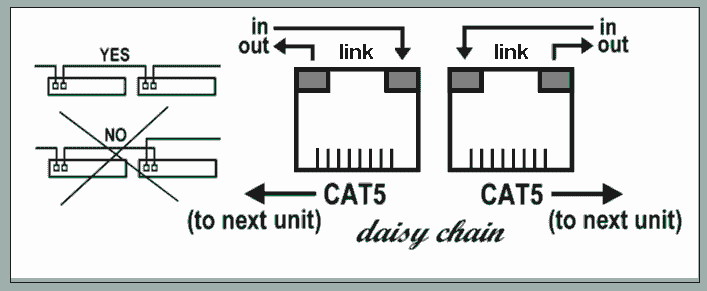

Two green LEDs on each connector indicate outgoing and incoming link status. If the unit is powered on, the outgoing LEDs should always be lit. The incoming LEDs should be lit when another unit capable of transmitting onto the CAT5 cable is connected to it with a CAT5 cable, and is also powered on. These LEDs indicate the presence of a proper link only. They do not indicate the presence or absence of ADAT Lightpipe audio, nor do they blink with data activity.
The physical cabling guidelines are the same as for 100 Mb/s Ethernet. Any Category 5 ("CAT5") Unshielded Twisted Pair ("UTP") wiring scheme can be used in a residential through light industrial environment. In a heavy industrial environment, such as near broadcast transmitters, use Shielded Twisted Pair ("STP") cable. Use normal straight cable and connections, not crossover cable or crossed connections. (Note: If crossover cable or connections are already a given, simply wire according to the "NO" diagram. In this case, two wrongs make a right. Inside the AudioRail enclosure, the only difference between the two ports is that one is crossed and one is not.)
Any number of AudioRail units can be daisy chained together. Each CAT5 cable can be any length, up to 100 meters (328 feet) maximum, per hop. Each hop adds about a quarter of a microsecond delay inside the unit, plus a half a microsecond for each 100 meters (328 feet) of cable. The encoding and decoding of the ADAT Lightpipe format adds about 4 to 5 microseconds total delay, from end to end. (This 4 to 5 microsecond delay is not compounded from hop to hop. It is incurred only once, from end to end.)